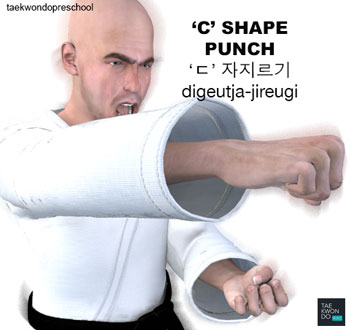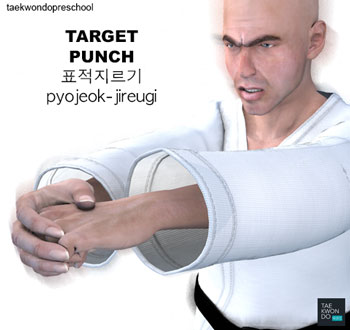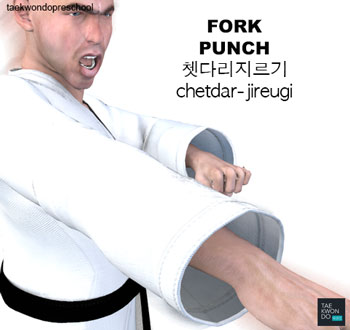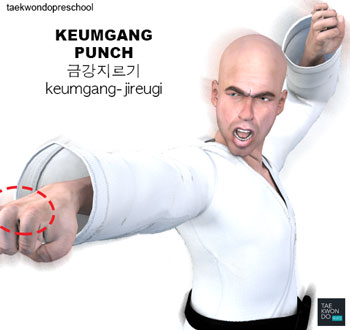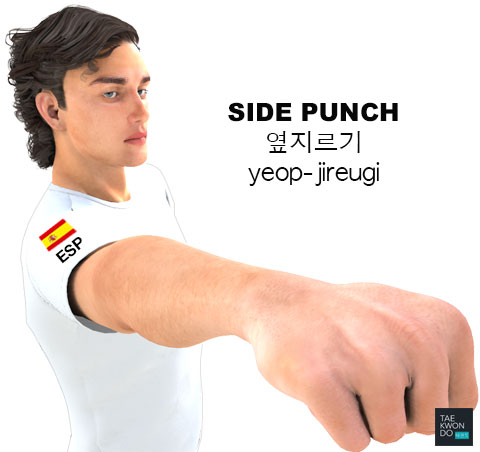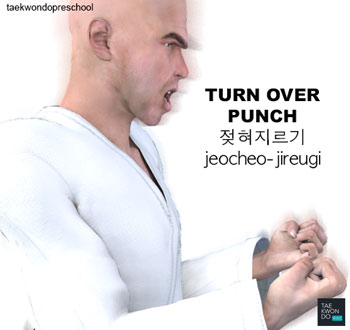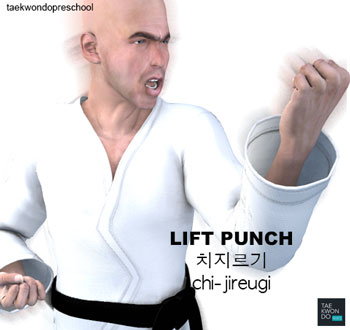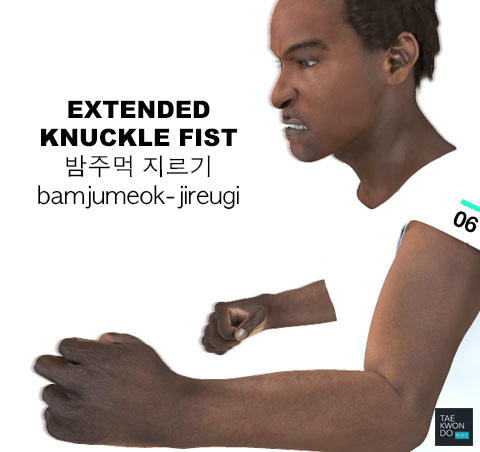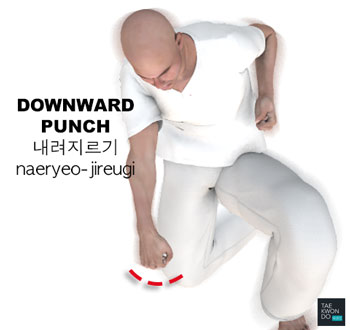Taekwondo 태권도Taekwondo Preschool
When you reach senior belt you are expected to guide the junior belts when they are beginning Taekwondo such as showing by example. To advance from one rank to the next, students typically complete promotion tests in which they demonstrate their proficiency in the various aspects of the art before a panel of judges or their teacher. View Taekwondo belt levels »
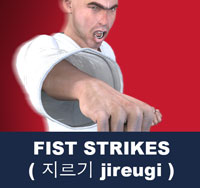
Fist Strikes
( 지르기 jireugi )
Physically, taekwondo develops strength, speed, balance, flexibility, and stamina. An example of the union of mental and physical discipline is the breaking of wooden boards, bricks or tiles, which requires both physical mastery of the technique and the concentration to focus one's power.
Taekwondo hand strikes are performed as a close distance alternative to kicks ( 차기 chagi ). They are executed in a number of ways - from standing, jumping, spinning and rushing forwards. Hand strikes make up fast combinations of strikes which can leave an opponent stunned and unable to defend himself most commonly in self defense ( 호신술 hosinsool ) applications. Muscles should only be tensed at the moment of imaginary impact in order to commute maximum power to any individual taekwondo technique.
Variations of Strikes
- Outward Strike ( 바깥치기 bakkat-chigi )
- Turning Strike ( 돌려치기 dollyeo-chigi )
- Inward Strike ( 안치기 an-chigi )
- Twisting Strike ( 비틀어치기 bitureo-chigi )
- Downward Strike ( 내려치기 naeryeo-chigi )
- Forward Strike ( 앞치기 ap-chigi )
- Side Strike ( 옆치기 yeop-chigi )
- Upward Strike ( 올려치기 olgul-chigi )
- Target Strike ( 표적치기 pyojeok-chigi )
- Supporting Strike ( 거들어치기 kodureo-chigi )
- Pulling Strike ( 당겨치기 danggyeo-chigi )
The striker relaxes to the extent possible during the strike, tensing the muscles of much of the body only at the time of impact, then relaxing again to recoil the striking part. Relaxation enables the strike to achieve the greatest possible velocity during travel, while rigidity at impact allows the maximum transfer of force.
FIST PUNCH
( 주먹 지르기 jumeok-jireugi )
Difficulty Level: Beginner Tutorial Available
Fist Punch ( 주먹 지르기 jumeok-jireugi ) is a striking blow with the closed fist. A strike commonly performed in taekwondo, originating from a chambered position. A fist is an action where a hand has the fingers curled into the palm and the thumb retracted, displaying the knuckles. Strikes should generally be thrown with some measure of shifting body weight supporting the blow, as opposed to just the striking with the fist. Read more »
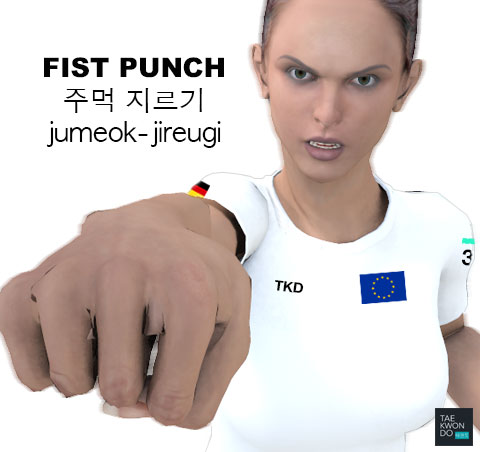
JAB STRIKE
Difficulty Level: Beginner Tutorial Available
The jab is a straight blow delivered generally from a distance, with the arm above the lead foot. The technique is quick and explosive, surprising an opponent. The jab is accompanied by a small, rotation of the torso and hips, while the fist rotates 90 degrees, becoming horizontal upon impact. As the punch reaches full extension, the lead shoulder can be brought up to guard the chin. The rear hand remains next to the face to guard the jaw. Read more »
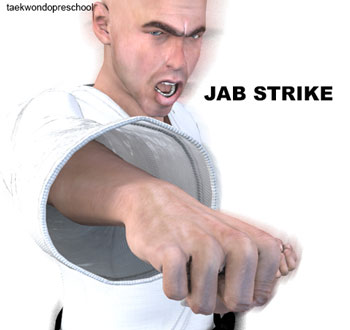
FRONT HAND MIDDLE PUNCH
( 몸통 반대 지르기 momtong-bandae-jireugi )
Difficulty Level: Beginner Tutorial Available
Front Hand Middle Punch ( 몸통 반대 지르기 momtong-bandae-jireugi ) is a punch that uses the same arm as the front leg to throw a punch to the opponent. The movement carries the weight of the body and power comes from turning the body. The wrist must also be kept in proper alignment during a fist strike. If the wrist bends on impact, it can easily be sprained, dislocated or broken. Read more »
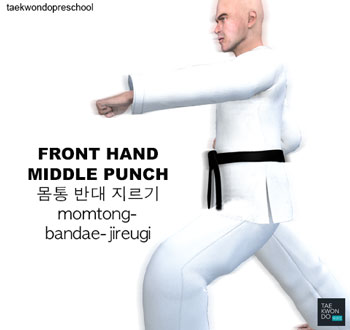
REVERSE (REAR HAND) MIDDLE PUNCH
( 몸통 바로 지르기 momtong-baro-jireugi )
Difficulty Level: Beginner Tutorial Available
Rear Hand Middle Punch ( 몸통 바로 지르기 momtong-baro-jireugi ) is a punch that uses the same arm as the back leg to throw a punch to the opponent. The movement carries the weight of the body and power comes from turning the body. The wrist must also be kept in proper alignment during a fist strike. Read more »
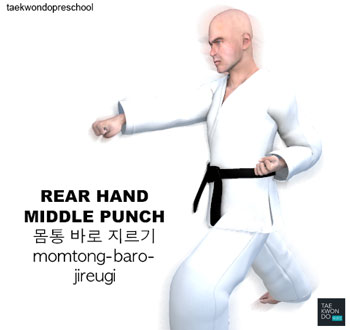
VERTICAL PUNCH
( 세워지르기 sewo-jireugi )
Difficulty Level: Intermediate Tutorial Available
Vertical Punch ( 세워지르기 sewo-jireugi ) is an intermediate technique that is executed turning the body and striking with the fist turned vertically. The hand has the fingers curled into the palm and the thumb retracted, displaying the knuckles. Power can be gained by using the turning force of the torso and hips. Read more »
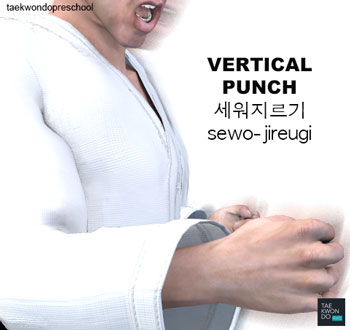
TURNING PUNCH
( 돌려지르기 dollyeo-jireugi )
Difficulty Level: Intermediate Tutorial Available
Turning Punch ( 돌려지르기 dollyeo-jireugi ) is an intermediate technique that strikes the side of the opponent's face or trunk with the lead hand. The strike is delivered in a circular motion like a hook and the opponent is standing right in front. The torso and hips are rotated, propelling the fist through a tight arc across the front of the body and connecting with the target. Read more »
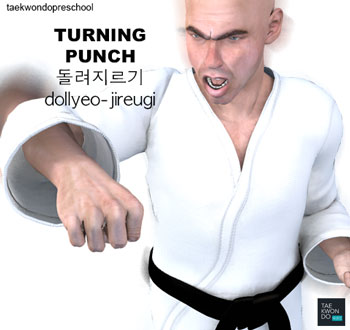
Risk of injury can be reduced by completing an effective warm up consisting of a heart raiser to get your pulse up, followed by sport specific dynamic stretches (stretches whilst moving). Please follow the guidance of a certified Master Instructor or trainer when doing sports related activities. Depending on the intensity of the exercise, cooling down can involve a slow jog or walk, or with lower intensities, stretching can be used. Cooling down allows the heart rate to return to its resting rate. View more information on Warming Up and Cooling Down ».
This article uses material from the Wikipedia articles "Warming Up" and "Cooling Down", which is released under the Creative Commons Attribution-Share-Alike License 3.0.
RESOURCES
This article uses material from the Wikipedia articles "List of Taekwondo Techniques", "Fist (hand)" and "Strikes (attack)", which is released under the Creative Commons Attribution-Share-Alike License 3.0.


